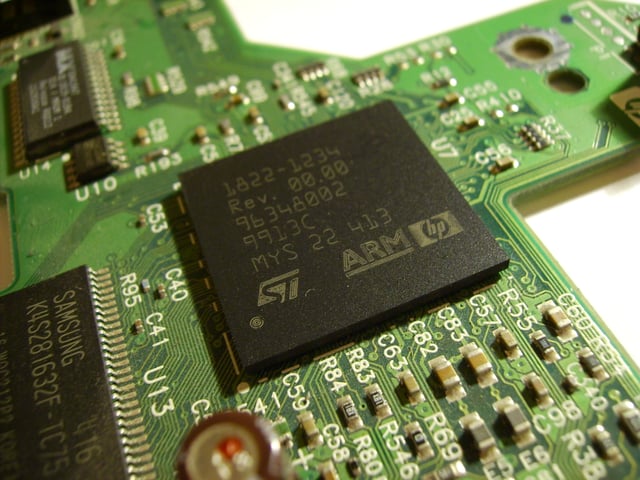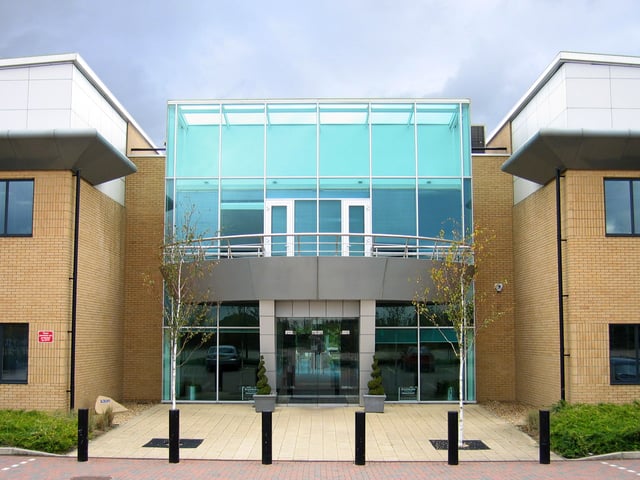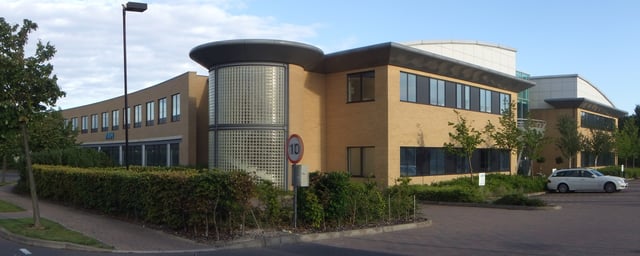ARM Holdings

ARM Holdings

Type | Subsidiary |
|---|---|
| Industry | Semiconductors |
| Founded | 27 November 1990 (1990-11-27)[2] |
| Founders | Jamie Urquhart, Mike Muller, Tudor Brown, Lee Smith, John Biggs, Harry Oldham, Dave Howard, Pete Harrod, Harry Meekings, Al Thomas, Andy Merritt, David Seal[3] and Hermann Hauser[4] |
| Headquarters | , |
Key people | Masayoshi Son (Chairman) Simon Segars (CEO)[5] |
| Products | Microprocessor designs and graphics processing unit (GPU) designs |
| Revenue | |
Operating income | |
Net income | |
| Total assets | US$3.21 billion (2016)[7] |
| Owner | SoftBank Group[1] |
Number of employees | About 6,250 (2018)[7] |
| Website | arm.com [164] |
Arm Holdings is a British multinational semiconductor and software design company, owned by SoftBank Group and its Vision Fund. With its headquarters in Cambridgeshire, in the United Kingdom, its primary business is in the design of ARM processors (CPUs), although it also designs software development tools under the DS-5, RealView and Keil brands, as well as systems and platforms, system-on-a-chip (SoC) infrastructure and software. As a "Holding" company, it also holds shares of other companies. It is considered to be market dominant for processors in mobile phones (smartphones or otherwise) and tablet computers. The company is one of the best-known "Silicon Fen" companies.[9]
Processors based on designs licensed from ARM, or designed by licensees of one of the ARM instruction set architectures, are used in all classes of computing devices (including in space[10][11]). Examples of those processors range from the world's smallest computer to the processors in a supercomputer on the TOP500 list.[12][13][14] Processors designed by ARM or by ARM licensees are used as microcontrollers in embedded systems, including real-time safety systems (cars' ABS),[15] biometrics systems (fingerprint sensor[16]), smart TVs (e.g. Android TV), all modern smartwatches (such as Qualcomm Toq), and are used as general-purpose processors in smartphones, tablets, laptops, desktops (even also for running, traditional x86, Microsoft Windows programs[17][18]),[19] servers[20] and supercomputers/HPC,[21][22][23] e.g. a CPU "option" in Cray's supercomputers.[24]
ARM's Mali line of graphics processing units (GPU) are used in laptops, in over 50% of Android tablets by market share,[25] and some versions of Samsung's smartphones and smartwatches (Samsung Galaxy Gear). It is the third most popular GPU in mobile devices.[26]
Systems, including iPhone smartphones, frequently include many chips, from many different providers, that include one or more licensed ARM cores, in addition to those in the main ARM-based processor.[27] ARM's core designs are also used in chips that support many common network related technologies in smartphones: Bluetooth, WiFi and broadband,[28] in addition to corresponding equipment such as Bluetooth headsets,[29] 802.11ac routers,[30] and network providers' cellular LTE.[31]
ARM's main CPU competitors in servers include Intel and AMD.[32] In mobile applications, Intel's x86 Atom is a competitor. AMD also sells ARM-based chips[33] as well as x86; MIPS Technologies offers another RISC design for embedded systems. ARM's main GPU competitors include mobile GPUs from Imagination Technologies (PowerVR), Qualcomm (Adreno) and increasingly Nvidia and Intel. Despite competing within GPUs, Qualcomm and Nvidia have combined their GPUs with an ARM licensed CPU.
ARM had a primary listing on the London Stock Exchange and was a constituent of the FTSE 100 Index. It also had a secondary listing on NASDAQ. However Japanese telecommunications company SoftBank Group made an agreed offer for ARM on 18 July 2016, subject to approval by ARM's shareholders, valuing the company at £23.4 billion (short scale).[34] The transaction was completed on 5 September 2016.[35][36]
Type | Subsidiary |
|---|---|
| Industry | Semiconductors |
| Founded | 27 November 1990 (1990-11-27)[2] |
| Founders | Jamie Urquhart, Mike Muller, Tudor Brown, Lee Smith, John Biggs, Harry Oldham, Dave Howard, Pete Harrod, Harry Meekings, Al Thomas, Andy Merritt, David Seal[3] and Hermann Hauser[4] |
| Headquarters | , |
Key people | Masayoshi Son (Chairman) Simon Segars (CEO)[5] |
| Products | Microprocessor designs and graphics processing unit (GPU) designs |
| Revenue | |
Operating income | |
Net income | |
| Total assets | US$3.21 billion (2016)[7] |
| Owner | SoftBank Group[1] |
Number of employees | About 6,250 (2018)[7] |
| Website | arm.com [164] |
History
Name
The acronym ARM was first used in 1983 and originally stood for "Acorn RISC Machine". Acorn Computers' first RISC processor was used in the original Acorn Archimedes and was one of the first RISC processors used in small computers. However, when the company was incorporated in 1990, What 'ARM' stood for changed to "Advanced RISC Machines", in light of the company's name "Advanced RISC Machines Ltd." - and according to an interview with Steve Furber the name change was also at the behest of Apple who did not wish to have the name of a former competitor - namely Acorn - in the name of the company. At the time of the IPO in 1998, the company name was changed to "ARM Holdings",[37] often just called ARM like the processors.
On 1 August 2017, the styling and logo were changed. The logo is now all lowercase and other uses of 'ARM' are in sentence case except where the whole sentence is upper case, so, for instance, it is now 'Arm Holdings'.[38]
Founding
The company was founded in November 1990 as Advanced RISC Machines Ltd and structured as a joint venture between Acorn Computers, Apple Computer (now Apple Inc.) and VLSI Technology.[39][40][41] The new company intended to further the development of the Acorn RISC Machine processor, which was originally used in the Acorn Archimedes and had been selected by Apple for their Newton project. Its first profitable year was 1993. The company's Silicon Valley and Tokyo offices were opened in 1994. ARM invested in Palmchip Corporation in 1997 to provide system on chip platforms and to enter into the disk drive market.[42][43] In 1998, the company changed its name from Advanced RISC Machines Ltd to ARM Ltd.[44] The company was first listed on the London Stock Exchange and NASDAQ in 1998[45] and by February 1999, Apple's shareholding had fallen to 14.8%.[46]
In 2010, ARM joined with IBM, Texas Instruments, Samsung, ST-Ericsson (since dissolved) and Freescale Semiconductor (now NXP Semiconductors) in forming a non-profit open source engineering company, Linaro.[47]
Acquisitions
1999
Micrologic Solutions, a software consulting company based in Cambridge[48]
2000
2001
The engineering team of Noral Micrologics, a debug hardware and software company based in Blackburn, England[52]
2003
Adelante Technologies of Belgium, creating its OptimoDE data engines business, a form of lightweight DSP engine[53]
2004
2005
KEIL Software, a leading developer of software development tools for the microcontroller (MCU) market, including 8051 and C16x platforms.[56] ARM also acquired the engineering team of PowerEscape.
2006
Falanx (now called ARM Norway), a developer of 3D graphics accelerators[57] and SOISIC, who specialise in developing silicon-on-insulator physical IP[58]
2011
2013
2014
PolarSSL, a software library implementing the SSL and TLS protocols.[63] (In February 2015, PolarSSL has been rebranded to mbed TLS to better show its fit inside the mbed ecosystem.[64])
Duolog Technologies, an electronic design automation company that developed a suite of tools that automate the process of IP configuration and IP integration[65]
2015
Sansa Security, a provider of hardware security IP and software for advanced system-on-chip components deployed in Internet of Things (IoT) and mobile devices[66]
Wicentric, a Bluetooth Smart stack and profile provider[67]
Sunrise Micro Devices, a provider of sub-one volt Bluetooth radio intellectual property (IP).[67]
Offspark, a provider of IoT security software[68]
Carbon Design Systems, a provider of cycle-accurate virtual prototyping solutions[69]
On 19 November, ARM, alongside Cisco Systems, Dell, Intel, Microsoft, and Princeton University, founded the OpenFog Consortium, to promote interests and development in fog computing.[70]
2016
Change of ownership
Operations
Business model
Unlike most traditional microprocessor suppliers, such as Intel, Freescale (the former semiconductor division of Motorola, now NXP Semiconductors) and Renesas (a former joint venture between Hitachi and Mitsubishi Electric), ARM only creates and licenses its technology as intellectual property (IP),[74] rather than manufacturing and selling its own physical CPUs, GPUs, SoCs or microcontrollers. This model is similar to fellow British design houses: ARC International, and Imagination Technologies (that both have stopped competing, at least as such, as both were bought out) who have similarly been designing and licensing GPUs, CPUs, and SoCs, along with supplying tooling and various design and support services to their licensees.
Facilities

An ARM processor in a Hewlett-Packard PSC-1315 printer
The company has offices and design centres across the world, including Cambridge, Bangor, Belfast, Glasgow, Loughborough, Manchester, Sheffield, Warwick in United Kingdom; San Jose, Austin, Chandler, Mountain View, San Diego, Waltham, Richardson and Bellevue in the United States; Vancouver in Canada; Bangalore and Noida in India; Copenhagen in Denmark; Oulu in Finland; Sophia Antipolis in France; Grasbrunn in Germany; Budapest in Hungary; Galway in Ireland; Ra'anana in Israel; Trondheim in Norway; Katowice in Poland; Sentjernej in Slovenia; Cape Town in South Africa; Lund in Sweden; Yokohama, Tokyo in Japan; Beijing, Shanghai, Shenzhen, in China; Hsinchu, Taipei in Taiwan; Seoul in South Korea.[75]
Technology
A characteristic feature of ARM processors is their low electric power consumption, which makes them particularly suitable for use in portable devices.[76] In fact, almost all modern mobile phones and personal digital assistants contain ARM CPUs, making them the most widely used 32-bit microprocessor family in the world. As of 2005, ARM processors accounted for over 75% of all 32-bit embedded CPUs.[77]
ARM processors are used as the main CPU for most mobile phones, including those manufactured by Apple, HTC, Nokia, Sony Ericsson and Samsung;[78] many PDAs and handhelds, like the Apple iPod and iPad,[79][80] Game Boy Advance, Nintendo DS, 3DS and Switch, PlayStation Vita, Game Park GP32 and GamePark Holdings GP2X; as well as many other applications, including GPS navigation devices, digital cameras,[81] digital televisions,[81] network devices and storage. The WLAN processor of Sony's PlayStation Portable is an older ARM9.[82]
Licensees
ARM offers several microprocessor core designs that have been "publicly licensed" 830 times including 249 times for their newer "application processors" (non-microcontroller) used in such applications as smartphones and tablets.[83] Three of those companies[84] are known to have a licence for one of ARM's 64-bit Cortex-A72 (some including ARM's other 64-bit core the Cortex-A53) and four have a licence to their most powerful 32-bit core, the Cortex-A15.
Cores for ARMv8.2-A include the Cortex-A77, Cortex-A65AE, Cortex-A76, Cortex-A75 and Cortex-A55. Cores for ARMv8-A include the Cortex-A73, Cortex-A72, Cortex-A32, Cortex-A35, Cortex-A57 and Cortex-A53. ARM's client roadmap includes Hercules in 2020.[85]
Cores for 32-bit architectures include Cortex-A32, Cortex-A15, Cortex-A12, Cortex-A17, Cortex-A9, Cortex-A8, Cortex-A7 and Cortex-A5, and older "Classic ARM Processors", as well as variant architectures for microcontrollers that include these cores: Cortex-R7, Cortex R5, Cortex-R4, Cortex-M4, Cortex-M3, Cortex-M1, Cortex-M0+, and Cortex-M0 for licensing; the three most popular licensing models are the "Perpetual (Implementation) License", "Term License" and "Per Use License".[86]
Companies often license these designs from ARM to manufacture and integrate into their own System on chip (SoC) with other components such as GPUs (sometimes ARM's Mali) or modem/radio basebands (for mobile phones). ARM also offers Artisan POP IP, where ARM partners with foundries to provide physical implementation, which allows faster time to market.
In February 2016, ARM announced the Built on ARM Cortex Technology license often shortened to Built on Cortex (BoC) license. This license allows companies to partner with ARM and make modifications to ARM Cortex designs. These design modifications will not be shared with other companies. These semi-custom core designs also have brand freedom, for example Kryo 280.[87]
In addition to licenses for their core designs and BoC license, ARM offers an "architectural license" for their Instruction set architectures, allowing the licensees to design their own cores that implement one of those instruction sets. An ARM architectural license is more costly than a regular ARM core license,[88] and also requires the necessary engineering power to design a CPU based on the instruction set.
Processors believed to be designed independently from ARM include Apple's (architecture license from March 2008[89]) A6, A6X, A7 and all subsequent Apple processors[90] (used in iPhone 5, iPad and iPhone 5S), Qualcomm's Snapdragon series[91] (used in smartphones such as the US version of the Samsung Galaxy S8) and Samsung's Exynos ("Mongoose" M1 cores).
ARM core licensees
Companies that are current or former licensees of 32-bit ARM core designs include AMD,[95] Broadcom,[96] Freescale (now NXP Semiconductors),[97][98] Huawei (HiSilicon),[99] IBM,[100] Infineon Technologies (Infineon XMC 32-bit MCU families),[101] Intel (older "ARM11 MPCore"), LG,[102][103] Microsemi,[104] NXP Semiconductors,[105] Renesas,[106] Rockchip,[94] Samsung,[107][108] STMicroelectronics,[109] and Texas Instruments.[110]
ARM architectural licensees
ARM Built on ARM Cortex Technology licensees
Mali licensees
Artisan POP IP
ARM Neoverse infrastructure
In October 2018, ARM rebranded their infrastructure portfolio under the ARM Neoverse brand and launched the ARM ServerReady certificate. Neoverse aims to scale from Servers, WAN Routers, Gateways, Cellular base stations and Top-of-Rack switches. Neoverse Platforms include Cosmos, Ares and in the future Zeus and Poseidon.[134] The Cosmos Platform includes the Cortex-A72 and Cortex-A75. The Ares Platform includes the Neoverse N1 and Neoverse E1.[135]
ARM supercomputers
The supercomputer maker Cray has added "ARM Option" (i.e. CPU blade option, using Cavium ThunderX2 CPUs) to their XC50 supercomputers, and Cray claims that ARM is "a third processor architecture for building next-generation supercomputers", for e.g. the US Department of Energy.[24]
Fujitsu (the supercomputer maker of June 2011 world's fastest K computer according to TOP500) announced at the International Supercomputing Conference in June 2016 that its future exascale supercomputer will feature processors of its own design that implement the ARMv8 architecture, rather than the SPARC processors used in earlier supercomputers. These processors will also implement extensions to the ARMv8 architecture equivalent to HPC-ACE2 that Fujitsu is developing with ARM Holdings.[136] The Fujitsu supercomputer post-K planned,[137] will use 512-bit scalable vector extension (ARMv8-A SVE) with "the goal of beginning full operations around 2021. [..] With post-K, Fujitsu and RIKEN aim to create the world's highest-performing supercomputer"; SVE is a new extension for ARMv8 allowing "implementation choices for vector lengths that scale from 128 to 2048 bits."[138] Fujitsu has started production of this 52-core A64FX processor to replace the supercomputer, and each chip is about 2.5 times faster than their SPARC chips, "with double-precision floating-point performance of 2.7TFLOPS".[139]
The Cray XC50-series supercomputer for the University of Bristol is called Isambard, named after Isambard Kingdom Brunel. The supercomputer is expected to feature around 160 nodes, each with two 32-core ThunderX2 processors running at 2.1 GHz. Peak theoretical performance of the 10,240 cores and 40,960 threads is 172 teraFLOPS.[140]
The Vanguard project by Sandia National Laboratories is to deliver a exascale ARM machine. The first generation was called Hammer, it was based on X-Gene by Applied Micro. The second generation was called Sullivan was based Cavium's ThunderXs processors. The third generation of the Sandia National Laboratories' Vanguard project called Mayer was based on pre-production ThunderX2 and consisted of 47 nodes. The fourth generation also based on ThunderX2 is called Astra and will become operation by November 2018. Each Astra node will feature two 28-core ThunderX2 processors running at 2.0 GHz with 128 GB DDR4. Each rack has 18x Hewlett Packard Enterprise Apollo 70 chassis with 72 compute nodes along with 3 InfiniBand switches. Astra will feature a total of 36 racks. Thus Astra will have 5,184 ThunderX2 processors, 145,152 ThunderX2 cores and 580,608 threads. Astra's peak theoretical performance is 4.644 PFLOPS in Single Precision, and 2.322 PFLOPS in Double Precision and will support 324 TB DDR4.[141] Astra is the first ARM-based Petascale supercomputer to enter the TOP500 list. As of November 2018 it is ranked at 204.[142]
Sales and market share
ARM-based CPU market share in 2010: over 95% in smartphone market; 10% in mobile computers; 35% in digital TVs and set-top boxes; however, ARM did not have any market share in servers and desktop PCs.[143] The first mobile phone to use an ARM processor was 1997's Nokia 6110 mobile phone.
As of 2014, over 50 billion chips with ARM cores inside have been produced, 10 billion of which were produced in 2013.[144]
In the fourth quarter of 2010, 1.8 billion chips based on an ARM design were manufactured.[145]
ARM's goal was to have, by 2015, ARM-based processors in more than half of all tablets, mini-notebooks and other mobile PCs sold.[149]
| Year | Billion units | Relative size |
|---|---|---|
| 2015 | 15 | 15 |
| 2014 | 12 | 12 |
| 2013 | 10 | 10 |
| 2012 | 8.7 | 8.7 |
| 2011 | 7.9 | 7.9 |
| 2010 | 6.1 | 6.1 |
| 2009 | 3.9 | 3.9 |
| 2008 | 4.0 | 4 |
| 2007 | 2.9 | 2.9 |
| 2006 | 2.4 | 2.4 |
| 2005 | 1.662 | 1.662 |
| 2004 | 1.272 | 1.272 |
| 2003 | 0.782 | 0.782 |
| 2002 | 0.456 | 0.456 |
| 2001 | 0.420 | 0.42 |
| 2000 | 0.367 | 0.367 |
| 1999 | 0.175 | 0.175 |
| 1998 | 0.051 | 0.051 |
| 1997 | 0.009 | 0.009 |
| Total | 78.094 |
Partnerships
University of Michigan
In 2011, ARM renewed a five-year, US$5 million research partnership with University of Michigan, which extended their existing research partnership to 2015. This partnership will focus on ultra-low energy and sustainable computing.[153][154]
- World's smallest computer
As of 21 June 2018, the "world's smallest computer", or computer device (made by University of Michigan team), is based on an ARM Cortex-M0+ core.[155]
Arduino
In October 2017, Arduino announced its partnership with ARM. The announcement said, in part, "ARM recognized independence as a core value of Arduino ... without any lock-in with the ARM architecture." Arduino intends to continue to work with all technology vendors and architectures.[156]
Intel
In October 2018, ARM Holdings partnered with Intel in order to share code for embedded systems through the Yocto Project.[157]
Senior management
Warren East was appointed Chief Executive Officer of ARM Holdings in October 2001. In the 2011 financial year, East received a total compensation of £1,187,500 from ARM, comprising a salary of £475,000 and a bonus of £712,500.[158][159] East said in March 2013 that he would retire from ARM in May, with president Simon Segars taking over as CEO.[160][161] In March 2014, former Rexam chairman Stuart Chambers succeeded John Buchanan as chairman. Chambers, a non-executive director of Tesco and former chief executive of Nippon Sheet Glass Group, had previously worked at Mars and Royal Dutch Shell.[162]
See also
Imagination Technologies
ARC International

